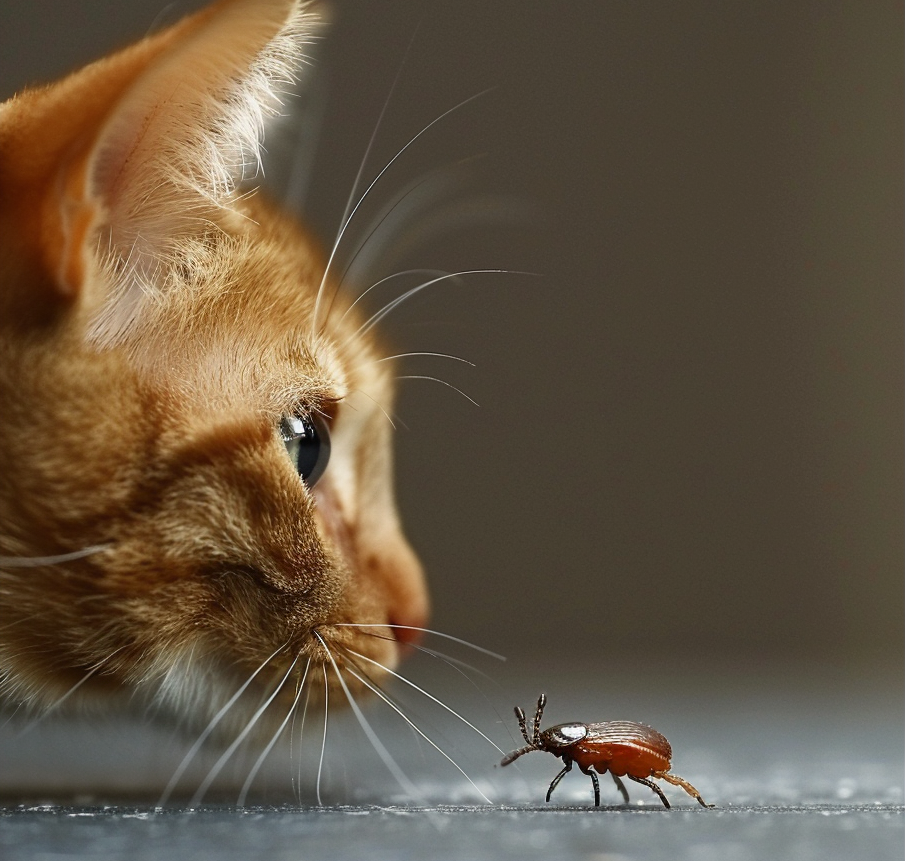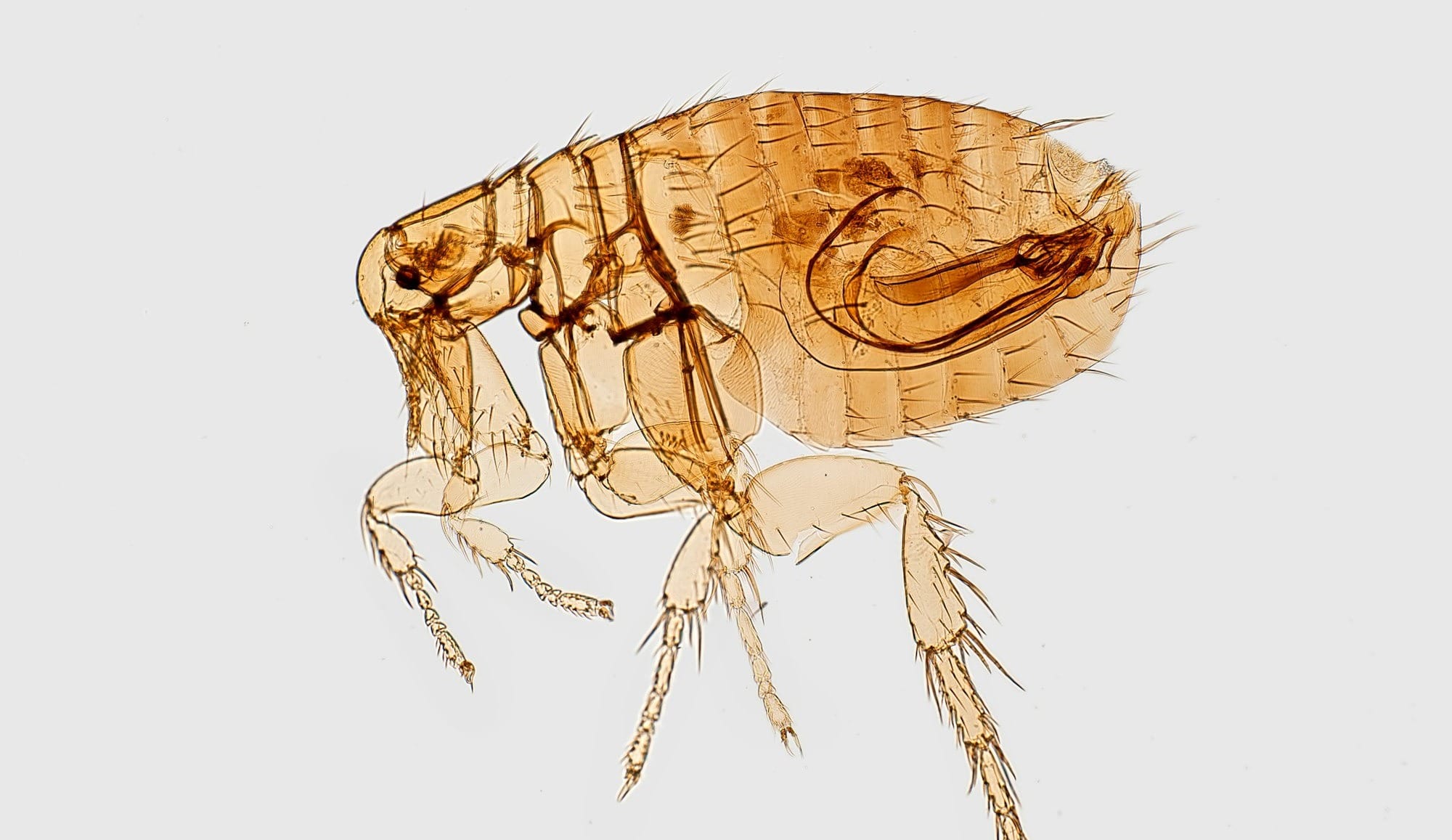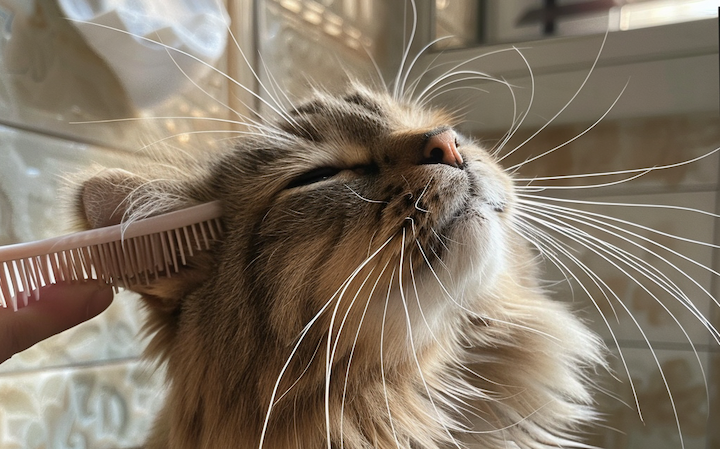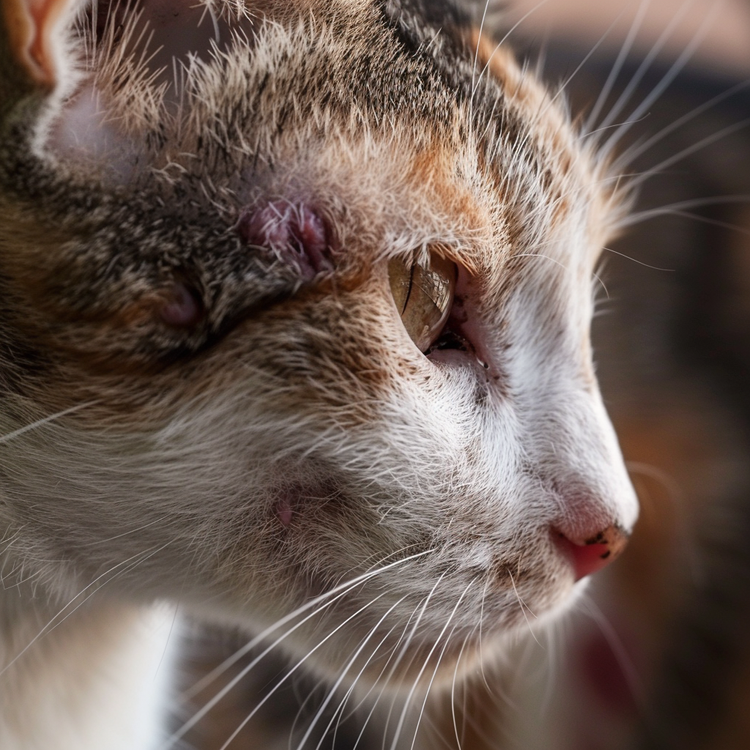Flea and Tick Control for Cats: Tips

Flea and tick prevention in cats is not merely a matter of comfort; it's a critical component of their health care regimen. These tiny parasites, though small, pose significant health risks that can go beyond mere irritation. Fleas can lead to conditions such as flea allergy dermatitis, anemia, and even contribute to the transmission of tapeworms. Ticks are equally hazardous, capable of spreading serious diseases like Lyme disease and anaplasmosis. Unfortunately, indoor cats are not immune to these threats, as these pests can find their way indoors through humans or other pets. Given the stealthy nature of fleas and ticks, coupled with their potential to cause severe health issues, it's vital for pet owners to adopt proactive measures in flea and tick control. This article aims to shed light on practical tips for effective flea and tick prevention, ensuring your feline friend remains healthy, happy, and pest-free.
Understanding Fleas and Ticks

To effectively combat the threats posed by fleas and ticks to our feline companions, it's crucial to grasp the intricacies of their development and survival strategies. These parasites are not just temporary nuisances; they're capable of causing severe health issues through their complex lifecycles. Here are some key insights into the lifecycles of fleas and ticks that highlight the necessity for a comprehensive approach to prevention and control:
To deepen your understanding of the challenges posed by fleas and ticks, it's beneficial to consider the following key points:
- Fleas' Rapid Life Cycle:
- Eggs can hatch within days in warm, humid conditions, rapidly increasing flea populations.
- Larvae feed on organic debris and flea dirt, hiding away from light in carpets, bedding, and cracks.
- Pupae can remain dormant for months, emerging as adults in response to vibrations or carbon dioxide, signaling the presence of a host.
- Adult fleas can live several weeks to several months, continuously laying eggs on the host.
- Ticks' Complex Development:
- Larvae and nymphs feed on smaller mammals or birds before reaching adulthood.
- Adult ticks seek larger hosts, such as cats, to feed and mate on.
- Each stage can last several months, with the entire lifecycle spanning up to 3 years.
- Ticks can survive a long time without a meal, making year-round vigilance necessary.
Understanding the detailed lifecycles of these parasites underscores the importance of adopting a comprehensive and proactive approach to prevention. It's not enough to treat your cat once symptoms appear; ongoing preventive measures and environmental management are crucial to interrupt these parasites' lifecycles and protect your feline friend's health.
Signs of Flea and Tick Infestations

Early identification of flea and tick infestations in cats is paramount for maintaining their health and ensuring their comfort. Recognizing the signs promptly can mitigate the adverse effects these parasites have on your beloved pet. Here are some key indicators to watch for:
- Excessive Grooming: Cats may lick, bite, or scratch their fur more than usual, trying to relieve the irritation caused by flea bites or tick presence.
- Hair Loss: Persistent scratching or grooming can lead to noticeable patches of hair loss, a direct consequence of the discomfort caused by infestations.
- Skin Irritation: Look for signs of redness, bumps, or rashes on your cat's skin, which can indicate a reaction to flea saliva or tick bites.
- Allergic Reactions: Some cats may develop more severe allergic reactions to flea bites, known as flea allergy dermatitis, resulting in intense itching and discomfort.
- Flea Dirt: These small, dark specks found in your cat's fur or bedding are actually flea feces, indicating an active flea infestation.
- Ticks on Skin: Ticks can often be found as small bumps on the skin, particularly around the ears, neck, and legs, where they attach to feed on your cat's blood.
Conducting regular checks of your cat's fur and skin is essential for catching these signs early. Part the fur to inspect closely for fleas, ticks, or symptoms of irritation. This proactive approach not only helps in identifying infestations at an early stage but also plays a crucial role in preventing the spread of diseases and ensuring the effective treatment of these pests.
Preventative Measures
Protecting your cat from the pervasive threats of fleas and ticks requires a multifaceted strategy. To maintain their health and comfort, it's critical to implement both direct preventative treatments and environmental management practices. Here’s an overview of effective measures:
Spot-on Treatments: These provide a convenient, once-a-month application that can effectively kill and repel both fleas and ticks, offering immediate relief and ongoing protection.
Recommendations
- Revolution Plus for Cats – Best 6-in-1 Spot-on | Click Here
- Bravecto Plus Topical Solution for Cats, >6.2-13.8 lbs | Click Here
- Advantage II Large Cat Vet-Recommended Flea Treatment & Prevention , Cats Over 9 lbs., 6-Month Supply | Click Here
- FRONTLINE Plus Flea and Tick Treatment for Cats Over 1.5 lbs., 3 Treatments | Click Here
- PetArmor Plus Flea and Tick Prevention for Cats, 6 Dose, Waterproof Topical, Fast Acting, Cats Over 1.5 lbs | Click Here
Oral Medications: Serving as another monthly preventative, these work systemically to kill fleas and ticks upon biting, safeguarding your cat from the inside out.
Recommendations:
- Comfortis Chewable Tablet for Dogs, 5-10 lbs & Cats 4.1-6 lbs | Click Here
Flea Collars: Designed for long-term use, flea collars can offer continuous pest repellant and killing action, lasting several months with a single application.
Recommendations:
- Fipukin Natural & Safe Flea and Tick Collar | Click Here
- Seresto Cat Vet-Recommended Flea & Tick Treatment & Prevention Collar for Cats | 8 Months Protection | Click Here
- Environmental Control:
- Regular vacuuming of floors, carpets, and furniture to remove any flea eggs, larvae, and adults from the living space.
- Weekly washing of your cat’s bedding in hot water to eliminate fleas and their eggs.
- Maintenance of yard space by keeping grass short and bushes trimmed to discourage flea and tick habitats.
These proactive steps form a comprehensive barrier against flea and tick infestation, protecting not just your feline friend but also your home environment from these parasites.
Natural and Non-Toxic Solutions
Tips for Preventing Flea and Tick Infestations in a Natural and Non-Toxic way
Ensuring your cat remains free from fleas and ticks is essential for their health and comfort, and it doesn't necessarily mean reaching for chemical solutions. Here are some effective, natural strategies to prevent these pests:
- Maintain your cat's health: A balanced diet strengthens their immune system, making their skin less inviting to parasites.
- Regular grooming: Brushing your cat frequently helps detect and remove fleas or ticks early, while fostering a stronger bond between you and your pet.
- Vacuum regularly: Keeping your home clean by vacuuming often and washing your cat's bedding in hot water minimizes potential infestations.
- Use diatomaceous earth: Sprinkle food-grade diatomaceous earth around areas your cat frequents to naturally kill fleas.
- Introduce beneficial nematodes: These natural predators reduce flea populations in your garden without harmful chemicals.
- Natural repellents: Create a homemade flea collar using a dilution of cat-safe essential oils like lavender or cedarwood to naturally repel fleas.
Remember, while natural methods are safer and often effective, they may require more frequent application compared to conventional treatments. Always consult with a veterinarian before trying new remedies, especially when it comes to applying anything directly to your cat or in their environment. These preventative measures can help keep your feline friend happy, healthy, and pest-free in a safe and natural way.
How to Treat Fleas and Ticks in a Non-Toxic and Natural Way
Discovering fleas or ticks on your beloved cat can be alarming, but there's no need to resort to harsh chemicals for treatment. Embrace these natural and non-toxic remedies for effective relief:
- Bathing: Use mild soap or a natural flea shampoo suitable for cats. A bath can help drown adult fleas and provide your pet with immediate comfort.
- Flea combing: After a bath, use a fine-toothed flea comb on your cat, dipping the comb in soapy water between uses to kill off any caught pests.
- Clean bedding: Wash all pet bedding in hot, soapy water and vacuum your home thoroughly to remove fleas and their eggs from the environment.
- Diatomaceous earth: Apply food-grade diatomaceous earth around your home to safely dehydrate and kill fleas.
- Yard maintenance: Mow your lawn regularly and clear debris to reduce tick habitats. Plant flea-repellent plants like lavender, chamomile, or lemongrass to naturally deter pests.
While these natural methods offer a safer alternative to chemical treatments, they may need to be applied more regularly to remain effective. Always observe your cat for any signs of discomfort or allergic reactions to new treatments and consult your veterinarian to ensure these methods are suitable for your cat's specific health needs.
Natural and Home Remedies
In the quest for flea and tick prevention, many cat owners turn to natural solutions and home remedies. Popular options include diatomaceous earth, a fine powder that can dehydrate fleas, and essential oil-based sprays, with oils like lavender and peppermint known for their repellent properties. Additionally, regular grooming with a flea comb can physically remove fleas from your cat’s fur.
However, while natural remedies can offer a less chemical approach to flea and tick management, it’s important to proceed with caution. Not all natural solutions are safe or effective for all cats, and some essential oils can be toxic if applied directly to the skin or ingested. Always consult with a veterinarian before trying new treatments, especially natural ones, to ensure they are safe for your specific cat.

Choosing the Right Flea and Tick Treatment
Selecting the appropriate flea and tick treatment for your cat involves more than just picking a product off the shelf. It requires careful consideration of your cat's age, health status, and lifestyle. For instance, kittens may need a gentler treatment compared to adult cats, and cats with health issues or sensitivities might not tolerate certain chemicals found in standard products. Moreover, outdoor cats are at a higher risk of infestation and might benefit from stronger or more frequent treatments.
One of the most crucial steps in this process is consulting with your veterinarian. They can provide personalized advice based on a thorough understanding of your cat's health history and specific needs. A veterinarian can also recommend the latest and most effective treatments available, including those that may not be readily available over the counter.
By taking into account these factors and seeking professional guidance, you can ensure that you choose the most effective and safe flea and tick treatment. This not only protects your cat from parasites and the diseases they carry but also contributes to the overall well-being and happiness of your feline friend.
Handling Infestations
If your cat is grappling with fleas or ticks, immediate action is crucial for their health and comfort. Begin by consulting your veterinarian for an effective treatment plan tailored to your cat's specific needs. Products such as spot-on treatments, oral medications, or medicated shampoos can offer immediate relief and begin the process of eradicating these pests.
Equally important is addressing the environment where your cat lives. Fleas and ticks can thrive in home settings, laying eggs that lead to reinfestation. Washing your cat’s bedding, vacuuming carpets, and cleaning furniture are essential steps. For outdoor areas, consider yard treatments that target fleas and ticks.
Remember, treating an infestation is a dual-front battle: while your cat receives direct treatment, the surrounding environment must be cleansed of pests to prevent future outbreaks. This comprehensive approach ensures your feline friend can return to their comfortable, playful self, free from the annoyance and danger of parasites.
Final Thoughts:
Maintaining vigilant flea and tick control practices is paramount in safeguarding your cat's health and well-being. These tiny parasites pose significant risks, but with consistent and comprehensive prevention strategies, they can be effectively managed. Encourage every cat owner to adopt a proactive stance towards flea and tick prevention, utilizing a blend of vet-recommended treatments and environmental controls. Remember, your veterinarian is your ally in this endeavor, offering invaluable advice tailored to your cat's unique needs. By working closely with your vet and staying diligent in your prevention efforts, you can ensure your feline friend enjoys a happy, healthy life free from the threats of fleas and ticks.


